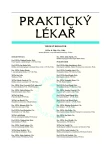The prevalence of asymptomatic individuals with high risk of cardiovascular disease in the Czech population and their adherence to primary prevention targets
Authors:
O. Mayer jr. 1; R. Cífková 2; J. Filipovský 1; J. Seidlerová 1; D. Slezák 1; J. Střížová 1; P. Vaněk 1; P. Wohlfart 2; J. Jeschke 1
Authors‘ workplace:
Univerzita Karlova v Praze
Lékařská fakulta a Fakultní nemocnice, Plzeň
II. Interní klinika
Přednosta: prof. MUDr. Jan Filipovský, CSc.
1; Institut klinické a experimentální medicíny, Praha
Pracoviště preventivní kardiologie
Přednosta: prof. MUDr. Renata Cífková, CSc.
2
Published in:
Prakt. Lék. 2010; 90(4): 230-234
Category:
Of different specialties
Overview
Asymptomatic individuals with increased risk of cardiovascular disease (CVD) are a priority for prevention immediately after patients with established CVD. We aimed to establish the prevalence of asymptomatic high-risk subjects in the Czech population and to evaluate the adherence to primary prevention targets. The study looked at a general population based sample of 616 subjects (mean age 47.2 years). The overall 10 years absolute risk of a fatal vascular event was estimated using SCORE function localized for Czech population.
In total, 24.8 % of the subjects were at high-risk because of SCORE ≥ 5 % or were already treated with cardiovascular medication (antihypertensives or lipid-lowering drugs). Using a projection of current risk into 60 years of age, the prevalence of high-risk individuals increased to 46.9 %. In addition, 8.5 % reported a manifestation of CVD or were diabetic. In asymptomatic high-risk individuals, 29.4 % were obese, 52.2 % had increased waist circumference and 51.6 % were active smokers. The proportion of patients with raised blood pressure was 37.4 %, while 70.9 % had hypercholesterolemia; 11.8 % of subjects showed increased fasting glycaemia.
In conclusion, in our study we found a high prevalence of asymptomatic individuals with increased risk of CVD, and that the therapeutic control of individual risk factors is far from optimal.
Key words:
asymptomatic high-risk, SCORE, primary prevention, guidelines; adherence.
Sources
1. Pyörälä, K., de Backer, G., Graham, I. et al. Prevention of coronary heart disease in clinical practice. Recomendation of the Task Force of the European Society of Cardiology, European Atherosclerosis Society and European Society of Hypertension. Eur. Heart. J. 1994, 15, p. 1300-1331.
2. Wood, D., De Backer, G., Faergeman, D. et al. Prevention of coronary heart disease in clinical practice. Recommendations of the Second Joint Task Force of European and other Societies on coronary prevention. Eur. Heart. J. 1998, 19, p. 1434-503.
3. De Backer, G., Ambrossioni, E., Borch-Johnsen, K. et al. European guidelines on cardiovascular disease prevention on clinical practice. Third joint Task Force of European and other societies on cardiovascular disease prevention in clinical practice. Eur. Heart. J. 2003, 24, p. 1601-1610.
4. Cífková, R., Býma, S., Češka, R. a kol. Prevence kardiovaskulárních onemocnění v dospělém věku. Společné doporučení českých odborných společností. Vnitř. lék. 2005, 51(9), s. 1021-1036.
5. Graham, I., Atar, D., Borch-Johnsen, K. et al. European guidelines on cardiovascular disease prevention in clinical practice: executive summary. Fourth Joint Task Force of the European Society of Cardiology and other societies on cardiovascular disease prevention in clinical practice (constituted by representatives of nine societies and by invited experts). Eur. J. Cardiovasc. Prev. Rehabil. 2007, 14 (Suppl 2), E1-113.
6. EUROASPIRE Study Group. EUROASPIRE. A European Society of Cardiology survey of secondary prevention of coronary heart disease: Principal results. Eur. Heart J. 1997, 18, p. 1569-1582.
7. EUROASPIRE II Group. Lifestyle and risk factor management and use of drug therapies in coronary patients from 15 countries. Principal results from EUROASPIRE II. Eur. Heart J. 2001, 22, p. 554-572.
8. Kotseva, K., Wood, D., De Backer, G. et al. EUROASPIRE Study Group. EUROASPIRE III: a survey on the lifestyle, risk factors and use of cardioprotective drug therapies in coronary patients from 22 European countries. Eur. J. Cardiovasc. Prev. Rehabil. 2009, 16, p. 121-137.
9. Mayer, O. Jr., Šimon, J., Galovcová, M. et al. The quality of secondary prevention of coronary heart disease in Czech patients in the EUROASPIRE III survey. Cor. Vasa 2008, 50, p. 156-162.
10. Bruthans, J., Mayer, O. Jr., Šimon, J. a kol. Úroveň sekudární prevence cevních mozkových příhod u českých pacietů ve studii EUROASPIRE III - stroke specific module. Cor. Vasa 2008, 50, p. 446-454.
11. Conroy, R.M., Pyörälä, K., Fitzgerald, A.P. et al. SCORE project group. Estimation of ten-year risk of fatal cardiovascular disease in Europe: the SCORE project. Eur. Heart J. 2003, 24, p. 987-1003.
12. Cífková, R., Škodová, Z., Lánská, V. et al. Trends in blood pressure levels, prevalence, awareness, treatment, and control of hypertension in the Czech population from 1985 to 2000/01. J. Hypertens. 2004, 22, p. 1479-1485.
13. Widimský, J. Jr., Cífková, R., Špinar, J. a kol. Doporučení diagnostických a léčebných postupů u arteriální hypertenze – verze 2007. Cor. Vasa 2008, 50, (kardio 5-22).
14. Haffner, S.M., Lehto, S., Rönnemaa, T. et al. Mortality from coronary heart disease in subjects with type 2 diabetes and in nondiabetic subjects with and without prior myocardial infarction. N. Engl. J. Med. 1998, 339, p. 229-234.
Labels
General practitioner for children and adolescents General practitioner for adultsArticle was published in
General Practitioner

2010 Issue 4
- Hope Awakens with Early Diagnosis of Parkinson's Disease Based on Skin Odor
- Memantine Eases Daily Life for Patients and Caregivers
- Metamizole vs. Tramadol in Postoperative Analgesia
- Memantine in Dementia Therapy – Current Findings and Possible Future Applications
- What Effect Can Be Expected from Limosilactobacillus reuteri in Mucositis and Peri-Implantitis?
Most read in this issue
- Myocarditis
- Subcutaneous traumatic rupture of the tibialis anterior tendon
- Occurrence of polycystic ovary syndrome and hyperadrogenemia in women with type 1 diabetes mellitus
- Heart failure with preserved systolic function of the left ventricle
